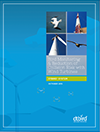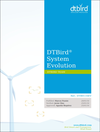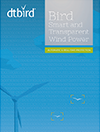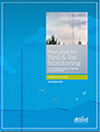
Notice: Undefined offset: 172 in /var/www/vhosts/dtbird.com/httpdocs/libraries/cms/menu/site.php on line 185
Notice: Undefined property: JObject::$description in /var/www/vhosts/dtbird.com/httpdocs/templates/paperplane/html/com_k2/templates/default/user.php on line 59
Results of the Pilot Evaluation of DTBirdV4D4 Detection and Collision Avoidance Modules in the USA
DTBird’s ability to detect and deter large raptors, particularly golden eagles, and to reduce the risk of collisions with wind turbines (WTG) was evaluated in the USA by H.T. Harvey & Associates for the American Wind Wildlife Institute.
The evaluation was carried out in 7 DTBirdV4D4 units installed in 2016 in a California wind farm, using eagle-like unmanned aerial vehicles (aka, UAV) with a 2 m wingspan, and studying in situ large raptor behavior registered during 2017.
The evaluation yielded the following major results:
- DTBirdV4 Detection Module:
- Up to 99%1 Overall eagle-like UAV Detection rate from > 230 m to the Rotor Swept Area (RSA).
- 63% mean Detection rate per distance band of 30 m (7 distance bands from >230 m to the RSA).
- 2.5 False Positive rate (flight recording of something other than birds)/WTG/day2.
- DTBirdD4 Collision Avoidance Module:
- Deterrence response rates3 when considering unequivocally successful deterrence and potential deterrence:
- 52-83% for golden eagles.
- 36-76% for buteos.
- 39-78% for all raptors.
- Deterrence response rates3 when considering unequivocally successful deterrence and potential deterrence:
- DTBirdV4D4 service reliability4:
- >98% System.
- >98% HD Cameras.
- 100% Collision Avoidance.
To see the original report with DTBird notes, please go to this Link.

DTBirdV4D4 unit installed at Manzana Wind Power Project.
Results of the Pilot Evaluation of DTBirdV4D4 Detection and Collision Avoidance Modules in the USA
DTBird’s ability to detect and deter large raptors, particularly golden eagles, and to reduce the risk of collisions with wind turbines (WTG) was evaluated in the USA by H.T. Harvey & Associates for the American Wind Wildlife Institute.
The evaluation was carried out in 7 DTBirdV4D4 units installed in 2016 in a California wind farm, using eagle-like unmanned aerial vehicles (aka, UAV) with a 2 m wingspan, and studying in situ large raptor behavior registered during 2017.
The evaluation yielded the following major results:
- DTBirdV4 Detection Module:
- Up to 99%1 Overall eagle-like UAV Detection rate from > 230 m to the Rotor Swept Area (RSA).
- 63% mean Detection rate per distance band of 30 m (7 distance bands from >230 m to the RSA).
- 2.5 False Positive rate (flight recording of something other than birds)/WTG/day2.
- DTBirdD4 Collision Avoidance Module:
- Deterrence response rates3 when considering unequivocally successful deterrence and potential deterrence:
- 52-83% for golden eagles.
- 36-76% for buteos.
- 39-78% for all raptors.
- Deterrence response rates3 when considering unequivocally successful deterrence and potential deterrence:
- DTBirdV4D4 service reliability4:
- >98% System.
- >98% HD Cameras.
- 100% Collision Avoidance.
To see the original report with DTBird notes, please go to this Link.

DTBirdV4D4 unit installed at Manzana Wind Power Project.
DTBirdV4D8 model is included in LIFE project
The model DTBirdV4D8 has been installed in the Wind Farm Terna, in Thrace (Greece) under the project LIFE12 BIO/GR/000554. This project aims to demonstrate the practical application of post-construction assessment and post-construction mitigation. DTBird was already participating in the LIFE project with the model DTBirdV4D4 that started operating at the Wind Farm and the Park of Energy Awareness (PENA) of CRES at Keratea (Greece) at the beginning of 2016.

DTBird model V4D8 installation in Wind Farm Terna, Greece.
DTBirdV4D8 model is included in LIFE project
The model DTBirdV4D8 has been installed in the Wind Farm Terna, in Thrace (Greece) under the project LIFE12 BIO/GR/000554. This project aims to demonstrate the practical application of post-construction assessment and post-construction mitigation. DTBird was already participating in the LIFE project with the model DTBirdV4D4 that started operating at the Wind Farm and the Park of Energy Awareness (PENA) of CRES at Keratea (Greece) at the beginning of 2016.

DTBird model V4D8 installation in Wind Farm Terna, Greece.
DTBird in Germany
At first, at the end of 2015, DTBirdV4 started operating in the offshore Platform FINO 1, over 40km offshore in the North Sea, contracted by the Bundesamt für Seeschiffahrt und Hydrographie (BSH). This year the models DTBirdV4D8 and DTBirdV8 have been installed for the first time in onshore wind turbines in Lower Saxony and Bavaria.
DTBird will participate in the following events, the first one giving the guest lecture of "Field Ornithology" at the University of Applied Sciences Weihenstephan-Triesdorf on April 10th. In the second event DTBird will attend WindEnergy Hamburg at hall A1, stand 203 on September 25-28th.

DTBird models installed in onshore wind turbines, Germany.
DTBird in Germany
At first, at the end of 2015, DTBirdV4 started operating in the offshore Platform FINO 1, over 40km offshore in the North Sea, contracted by the Bundesamt für Seeschiffahrt und Hydrographie (BSH). This year the models DTBirdV4D8 and DTBirdV8 have been installed for the first time in onshore wind turbines in Lower Saxony and Bavaria.
DTBird will participate in the following events, the first one giving the guest lecture of "Field Ornithology" at the University of Applied Sciences Weihenstephan-Triesdorf on April 10th. In the second event DTBird will attend WindEnergy Hamburg at hall A1, stand 203 on September 25-28th.

DTBird models installed in onshore wind turbines, Germany.
DTBird and DTBat start operating in The Netherlands

DTBird and DTBat start operating in The Netherlands















